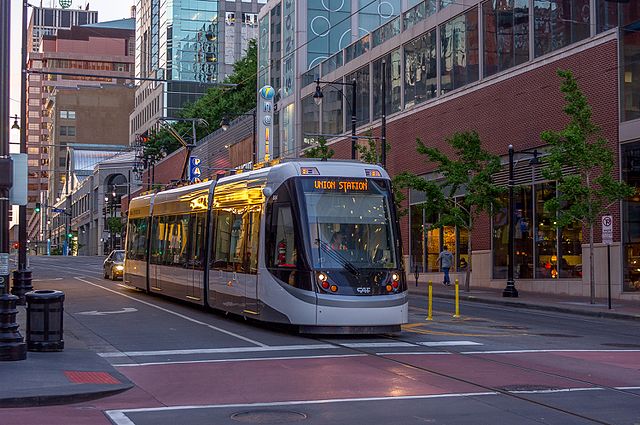Kansas City voters sensibly rejected spending money on light rail at least seven times. But that common sense apparently didn’t extent to streetcars, which are an even dumber idea than light rail as streetcars are slower than buses, far more expensive, and can’t get out of their own way if one breaks down.
Photo by Jason Doss.
Despite these disadvantages, Kansas City opened a 2.2-mile streetcar line in 2016 that it declared to be a great success. It carried almost 4,800 weekday riders in its first full year of operation, which is about as many as a mediocre bus route but more than streetcar lines in Atlanta, Charlotte, Cincinnati, Dallas, Little Rock, Seattle, Tucson, and Washington.
What made it so successful, at least relative to other streetcar lines, was that Kansas City never made the mistake that other cities made of actually asking people to pay to ride it. So the city is providing an expensive service for free when it could offer a better, less-expensive bus service and collect fares. (Though it has since stopped collecting bus fares too.)
Now it is extending the streetcar line. One 3.5-mile extension will replace part of one of the city’s bus-rapid transit lines and is expected to cost $227 million, or $65 million a mile. So it will replace a moderately fast, inexpensive bus with a slower, more-expensive streetcar that it doesn’t dare collect fares for out of fear that no one will ride it.
The other extension was originally projected to cost $22.2 million for .75 miles, two-thirds of which is being covered by a federal grant. But costs quickly rose to $34.9 million and are now expected to go over that by nearly $10 million, which would make the cost about $59 million a mile. In other words, the extension will have a 100 percent cost overrun. But hey — why count the costs when you are providing a service that is so valuable that you don’t dare ask anyone to pay to use it?









Ok, compromise
Buses that look like trains.
https://i.pinimg.com/736x/f4/2d/f6/f42df6547088d30a5f22f6366ffcff2d–buses-rv.jpg
We’ve fallen down a rabbit hole into a nightmare land where most fire engine calls are in response to traffic crashes, our fire engines that cost a fortune are too big to operate anywhere other than on wide streets and most car crashes occur because our streets are too wide.
Point of diminishing returns meets murphys law
https://denvergazette.com/aurora/denver-fire-moratorium-new-traffic-circles/article_bf0a05b4-5749-11ee-8a5f-fb68a08f187b.html?utm_medium=social&utm_source=twitter&utm_campaign=user-share
Honolulu provides an excellent example of spending lots of money on something that is essentially being given away, relative to its actual cost.
Our $9.93 billion rail system recently opened the first 10.7 miles seven years late, and 3.5 years later than we were contractually obligated to open the full 20.1 mile route, despite dropping the last 1.2 miles and two stations (to 18.9 miles, 19 stations).
The O&M is estimated to be $94 million to $129 million for the first year, depending on which interview with Dept of Transportation Services officials you read. hart also estimated rail revenues for the first year of interim operations at $3 million in a previous “recovery” plan, so we are on the hook for a $250k to $350k per day shortfall, in round numbers.
Ridership for August was 96,178, or 3,102 riders per day. I’m guessing that with all the discounts, yearly caps and free transfers, the rail probably sees an actual fare yield of approximately $1 per ride on a $3 fare, making the $3 million fare revenue estimate a very long shot. My best estimate puts the cost per ride at around $60.
Like our bus and handi-van, and difference between the fare box and O&M costs will be paid out of our general fund, over 75% of which is property tax revenues. Looks like we better buckle up. It’s going to be a rough ride.
Trams are higher capacity than a bus, and can maneuver much better than an articulated bus since it is on rails. Plus, it is simply more efficient than a bus. Trams are also not inherently slow, they just tend to be slower for pedestrian safety (which is often ignored by automobiles). The downside of a tram is since it is on rails it lacks a level of dynamic adaptability that a bus has, and has a much higher initial cost.
Trams can’t make this right turn. Buses can. They are _LESS_ maneuverable.
https://maps.app.goo.gl/BBfS1BMpahfiDvgi8
I should have clarified that its in relation to a similar sized bus, obviously a single bus is more manueverable than an articulated one twice its size, but for similar sizes a tram is more maneuverable
“most car crashes occur because our streets are too wide.”
LazyReader brings the lazy disinformation again.
Here’s actual data on car crashes.
https://crashstats.nhtsa.dot.gov/Api/Public/ViewPublication/811366
“about $59 million a mile.” how many years could a bus service with driver do this better?